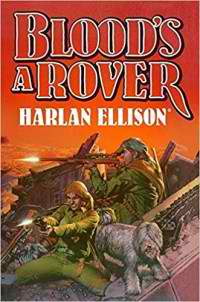Blood's a Rover by Harlan Ellison (Jason Davis, ed.)
 Wednesday, August 22, 2018 at 10:56AM
Wednesday, August 22, 2018 at 10:56AM 
Published by Subterranean Press on June 30, 2018
The introduction of Blood’s a Rover explains how Harlan Ellison’s brilliant novella, “A Boy and His Dog” (eventually filmed as a pretty good movie starring Don Johnson) was followed by some other stories in the same universe, and a treatment for a television show that NBC decided not to pick up, and an eventual full-length novel that Ellison started to write before suffering a stroke. This volume collects much of that material. The series is set in a post-apocalyptic world reduced to “radiation and rubble,” overseen by “the new masters of desolation: vicious roverpaks of parentless young boys … and their telepathic dogs.”
Placed in chronological order (as opposed to the order in which Ellison wrote them), the volume starts with “Eggsucker.” Blood, the dog who narrates the story, has been with Vic for about two years when the story starts. By the end, they’re thinking of splitting up, each blaming the other for an incident that will definitely require them to leave town. But they need each other even if Vic’s refusal to listen to reason (Blood being the reasonable one) sometimes impairs their partnership.
“A Boy and His Dog” sends Vic in search of a girl Blood found for him. After a harrowing experience together, the girl flees, and Vic pursues her over Blood’s objection. She lives in an underground version of Topeka, which Ellison uses to lampoon the notion that Midwestern Christian “values” make their adherents superior to people who are less judgmental and more open to experience (and I say that as someone who lived most of his life in the Midwest). The story is gripping from its inception until Vic makes his way out of Topeka with the girl, but the story saves its best moment for a gut-punch surprise in the very last sentence. One of the story’s themes involves the meaning of loyalty, and how true friendships are those that survive adversity (as opposed to plastic “use you and lose you” friendships). One of the story’s messages — a classic Ellison message — is, if you find security in living a dull and uneventful life, that’s your choice, but don’t force conformity to your social ideals on people who understand that freedom begins with the freedom to disagree. “A Boy and His Dog” might be Ellison’s best story. It’s certainly in the top three.
“Run, Spot, Run” takes place a few days after “A Boy and His Dog.” Vic is having some trouble coping with his actions, and Blood is having some trouble coping with Vic’s dreams. I don’t want to spoil the story so I’ll just say that it comes with the kind of gut-punch ending that was Ellison’s trademark.
“Blood’s a Rover” is the unproduced screenplay. The story brings back Vic and introduces a new character, a girl named Spike. Unsurprisingly, Vic doesn’t like Spike much, but Blood plays peacemaker because a girl and a boy and his dog have a better chance of survival than a boy and his dog — as Blood eventually proves. The screenplay doesn’t have the same bite as the original story, and certainly isn’t as compelling as Ellison’s best teleplays, but it would have been fun to watch.
Scattered throughout the volume are snippets of Blood’s wit and wisdom.
The volume was released shortly before Ellison’s death. It is something a true Ellison fan (in the sense of fanatic) will want to have. Other readers might be better served by picking up Ellison’s The Beast that Shouted Love at the Heart of the World, an excellent story collection that includes “A Boy and His Dog.”
RECOMMENDED
Reader Comments